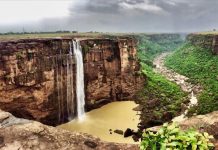List of renamed Indian states; Do you Know about this?
Indian states and cities can both be renamed by legislation at respective union/state levels. Article 3 of the constitution prescribes area/boundaries/territories/names of states can be changed by passing an act with simple majority, even if such change is not requested by the states.
If such a change is not initiated by the state assembly, the President is required to seek views of the states concerned but has the privilege to consider or discard such views before recommending such bill to the parliament. So far there had been amendments, many states had been renamed in India.
Here we have gathered a list the Indian states that have been renamed after independence:
1) Hyderabad to Andhra Pradesh : Hyderabad State existed from 1948 to 1956. It was merged with Andhra State following the States Reorganisation Act and was renamed Andhra Pradesh in the year 1956.

2) Travancore- Cochin to Kerala : Travancore-Cochin or Thiru-Kochi was a short-lived state of India (1949–1956). It was originally called United State of Travancore and Cochin and was created on 1 July 1949 by the merger of two former Princely States, the kingdoms of Travancore and Cochin with Trivandrum as the capital. It was renamed State of Travancore-Cochin in January 1950. On November 1, 1956, Travancore-Cochin was joined with the Malabar District of Madras State to form the new state of Kerala.
3) Uttaranchal to Uttarakhand : Uttaranchal is the erstwhile name of Northern Indian hill state, Uttarakhand. When Uttarakhand was carved out as a separate state from Uttar Pradesh in 2000, the then BJP led Government gave the name “Uttaranchal” which for some time continued to be the official name of the state. The locals who crusaded for the separation of the state since many years were unhappy with the name “Uttaranchal” as their movement was called “Uttarakhand” movement and saw this as a political move. It was in 2006–07 when the Congress Government passed the bill and declared “Uttarakhand” as the official name. “Uttar” in Hindi means North, while “khanda” means land. The bill was passed and signed by late President A.P.J. Abdul Kalam in December 2006, it was renamed to Uttarakhand.

4) Orissa to Odisha :The then Indian President Pratibha Patil approved the Orissa (Alteration of Name) Bill, 2010, the Constitution (113th Amendment) Bill. People of this State had not coined the words Orissa or Oriya or Urisha or Uriya to pronounce and spell the name of their land or language. The non-Oriyas – Indian and foreigners – had to develop these spellings by using ‘R’ for approximately correct pronunciation of the concerned Oriya words. The Bill, which called for the change of the name of the state language, officially changed the name of the state to Odisha and its language from Oriya to Odia.

5) Madras state to Tamil Nadu : After Indian Independence, the Madras Presidency became the Madras Province on 15 August 1947. On 26 January 1950 it was formed as Madras State by the Government of India. As a result of the 1956 States Reorganisation Act, the state’s boundaries were re-organised following linguistic lines. The state was finally renamed as Tamil Nadu on 14 January 1969 by C.N.Annadurai Chief Minister From DMK. The name change itself was first presented in the upper house (Rajya Sabha) of the Parliament of India by Bhupesh Gupta, a communist MP from West Bengal, but was then defeated. With Annadurai as chief minister, the state assembly passed the bill of renaming the state successfully. It was during the period of his Chief Ministership that the Second World Tamil Conference was conducted on a grand scale on 3 January 1968. Also, when a commemorative stamp was released to mark the Tamil conference, Annadurai expressed his dissatisfaction that the stamp contained Hindi when it was for Tamil.

6) East Punjab to Punjab : East Punjab (known simply as Punjab from 1950) was a province and later a state of India from 1947 until 1966, consisting of the parts of the Punjab Province of British India that went to India following the partition of the province between India and Pakistan by the Radcliffe Commission in 1947. The mostly Muslim western parts of the old Punjab became Pakistan’s West Punjab, later renamed as Punjab Province, while the mostly Hindu and Sikh eastern parts went to India. In the year 1950, after the Constitution of India came into effect, the province was renamed as Punjab.

7) United Province to Uttar Pradesh : After independence in 1947, the princely states of Rampur, Banaras (now Varanasi) and Tehri-Garwal were merged into the United Provinces. Later, on January 25 in the year 1950, this unit was renamed as Uttar Pradesh. The state is divided into 18 divisions and 75 districts with the capital being Lucknow.
8) Madhya Bharat to Madhya Pradesh : Madhya Bharat also known as Malwa Union, was an Indian state in west-central India, created on 28 May 1948[2] from twenty-five princely states which until 1947 had been part of the Central India Agency, with Jiwajirao Scindia as its Rajpramukh.
The union had an area of 46,478 square miles (120,380 km2). Gwalior was the winter capital and Indore was the summer capital. It was bordered by the states of Bombay (presently Gujarat and Maharashtra) to the southwest, Rajasthan to the northeast, Uttar Pradesh to the north, Uttar Pradesh and Vindhya Pradesh to the east, and Bhopal State and Madhya Pradesh to the southeast. The population was mostly Hindu and Hindi-speaking. On 1 November 1956, Madhya Bharat, together with the states of Vindhya Pradesh and Bhopal State, was merged into Madhya Pradesh.

9) Rajputana to Rajsthan : Rājputāna meaning “Land of the Rajputs”, was a region in India that included mainly the present-day Indian state of Rajasthan along with parts of Madhya Pradesh, Gujarat and some adjoining areas of Sindh in modern-day southern Pakistan. The main settlements were to the west of the Aravalli Hills, and was known as Gurjaratra, the earlier form of Gujarat, before it came to be known as Rajputana, early in the Medieval Period. The name was later adopted by British government as the Rajputana Agency for its dependencies in the region of the present-day Indian state of Rājasthān. The Rajputana Agency included 18 princely states, two chiefships and the British district of Ajmer-Merwara. This British official term remained until its replacement by “Rajasthan” in the constitution of 1949.
Ever since the end of the British imperial period in India in 1947, renaming of many states throughout India has taken place. However certain old names of the Indian states continue to be popular even today.


















